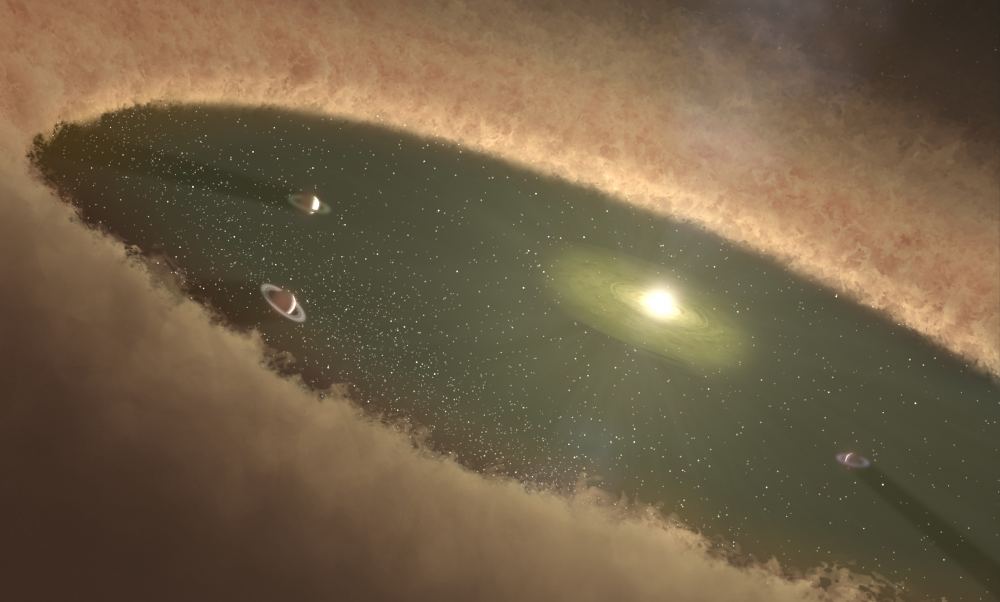I don’t know if you’ve noticed by now, but the Earth is a little bit wet. How Earth got all its water is one of the major mysteries in the formation of the solar system, and a team of Japanese researchers have just uncovered a major clue. But not on Earth – the clue is on Mercury.
Here’s the traditional story of the early solar system as best we know it. The sun forms with a disk of dusted gas surrounding it. Within a certain distance from the sun, known as the snow line, the sun’s radiation is too hot and too intense to support the formation of ices or lighter elements. Hence, the rocky planets form.
Beyond the ice line, which sits somewhere around the present-day orbit of the asteroid belt, ices and light elements can glue themselves together to become the giant bulky planets of the outer system.
In between is a sort of no man’s land of rocks, ices, debris, and basically a whole bunch of other junk.
Once the giant planets form, they rearrange themselves, and their gravitational influence sends chunks of random junk plowing into the inner solar system, delivering all sorts of goodies like water. Those goodies land on the surfaces of the rocky worlds, where they sit for billions of years.
But a team of Japanese researchers are challenging this view by looking at the cratering record on Mercury. To explain the abundance of lighter elements within Mercury’s crust, there has to be at least three times as many impacts as we observe in the cratering record. (And if you’re wondering why we’re so fascinated by Mercury, it’s because that airless, dead world doesn’t have any erosion, so it can preserve the memory of bombardments from billions of years ago).
To explain the discrepancy, the researchers believe that the bombardments were powerful enough to literally chew up the crust of Mercury, turning it into a molten sludge. That way most of the lighter and more volatile elements that the bombardments delivered ended up buried deep underground.
And as for the Earth? A similar process may have happened, with most of the water delivery provided by those early bombardments sunk deep beneath the surface. Thankfully they delivered enough water to leave the Earth with a healthy supply of oceans.
The upcoming European Space Agency’s BepiColombo mission, currently on route to Mercury, will unlock even more answers.


Thanks – it will be interesting to see how volatiles were sourced.
Personally I’m not sure I can find that there has to be at least three times as many impacts as we observe in the cratering record in the reference, but it notes that the Mercury crater record may have been erased at 4.1 Ga.
Impressive that it sounds – and I like that the paper rely on an exponential decay tail rather than the outdated “late bombardment” hypothesis – the model paper reference is rather inconclusive. From “Impact bombardment chronology of the terrestrial planets from 4.5?Ga to 3.5?Ga”, Brazier et al., 2020: “Our calculated lunar, martian and mercurian chronologies use the impacts recorded onto the planets from dynamical simulations rather than relying on the decline of the population as a whole. … Yet, neither of our dynamical timelines fit well with that of Neukum. The dynamical lunar and martian chronologies are also different from each other. Consequently, the usual extrapolation of such chronologies from one planetary body to the other is technically inappropriate.” The model is alluring: “If it is assumed that all the planetesimals have the same size and are far more numerous than the planets, then the relative amount of mass delivered to the terrestrial planets by late accretion should scale as the ratio of their gravitational cross sections and the number density and orbital distribution of objects that cross the orbit of each planet.” But its test is outstanding: “We end with one prediction from this work. If our dynamical chronology model is correct then the lunar HSE abundances and Os isotopes should reflect the composition of the material that made up the leftover planetesimals and the E-belt. Fischer-Gödde & Becker (2012) suggest that late accretion to the Moon consisted of a mixture of material akin to enstatite and carbonaceous chondrites. If future measurements confirm these results, then it may be possible that a ‘carbonaceous chondrite’ signal may instead be a remnant of the very early cometary contribution.”
An alternative hypothesis specifically for water is AFAIK contributions from production by core derived hydrogen reacting with silicate oxides in an early magma ocean.
Is there any estimate regarding the number of asteroid hits the Earth endured? I’m thinking in terms of 1 asteroid of x mass/size delivers y gallons of water. Earth has z gallons of water so it’s an easy calculation to determine the total hits – if not in number, then mass.